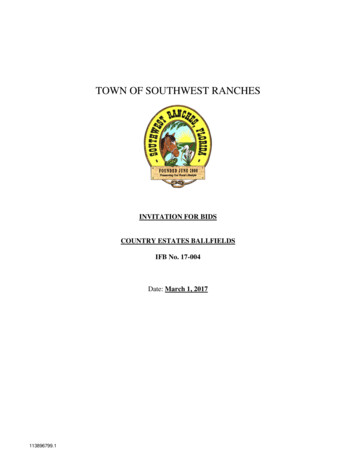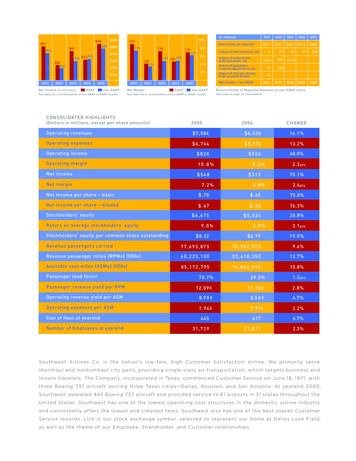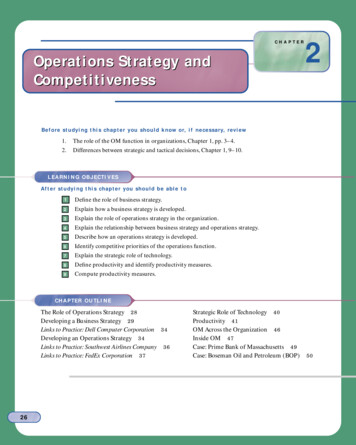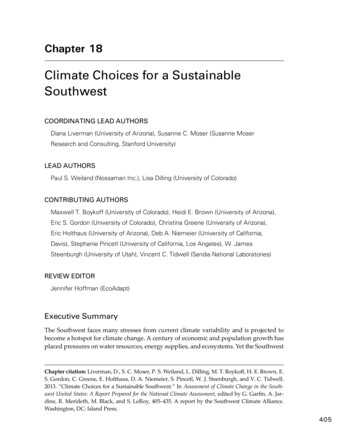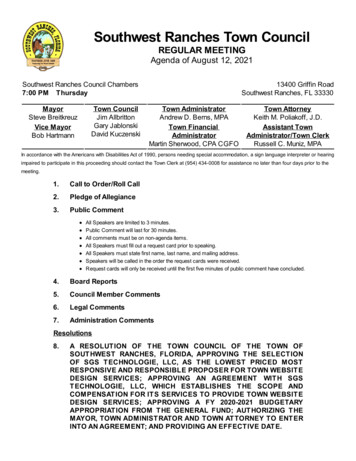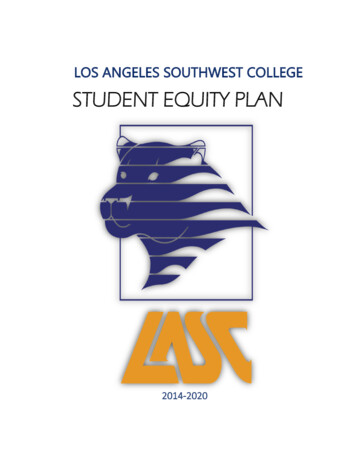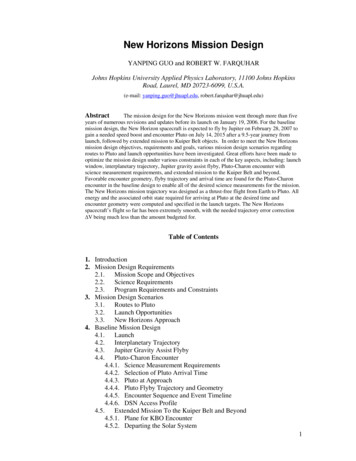
Transcription
New Horizons Mission DesignYANPING GUO and ROBERT W. FARQUHARJohns Hopkins University Applied Physics Laboratory, 11100 Johns HopkinsRoad, Laurel, MD 20723-6099, U.S.A.(e-mail: yanping.guo@jhuapl.edu, robert.farquhar@jhuapl.edu)AbstractThe mission design for the New Horizons mission went through more than fiveyears of numerous revisions and updates before its launch on January 19, 2006. For the baselinemission design, the New Horizon spacecraft is expected to fly by Jupiter on February 28, 2007 togain a needed speed boost and encounter Pluto on July 14, 2015 after a 9.5-year journey fromlaunch, followed by extended mission to Kuiper Belt objects. In order to meet the New Horizonsmission design objectives, requirements and goals, various mission design scenarios regardingroutes to Pluto and launch opportunities have been investigated. Great efforts have been made tooptimize the mission design under various constraints in each of the key aspects, including: launchwindow, interplanetary trajectory, Jupiter gravity assist flyby, Pluto-Charon encounter withscience measurement requirements, and extended mission to the Kuiper Belt and beyond.Favorable encounter geometry, flyby trajectory and arrival time are found for the Pluto-Charonencounter in the baseline design to enable all of the desired science measurements for the mission.The New Horizons mission trajectory was designed as a thrust-free flight from Earth to Pluto. Allenergy and the associated orbit state required for arriving at Pluto at the desired time andencounter geometry were computed and specified in the launch targets. The New Horizonsspacecraft’s flight so far has been extremely smooth, with the needed trajectory error correctionΔV being much less than the amount budgeted for.Table of Contents1. Introduction2. Mission Design Requirements2.1. Mission Scope and Objectives2.2. Science Requirements2.3. Program Requirements and Constraints3. Mission Design Scenarios3.1. Routes to Pluto3.2. Launch Opportunities3.3. New Horizons Approach4. Baseline Mission Design4.1. Launch4.2. Interplanetary Trajectory4.3. Jupiter Gravity Assist Flyby4.4. Pluto-Charon Encounter4.4.1. Science Measurement Requirements4.4.2. Selection of Pluto Arrival Time4.4.3. Pluto at Approach4.4.4. Pluto Flyby Trajectory and Geometry4.4.5. Encounter Sequence and Event Timeline4.4.6. DSN Access Profile4.5. Extended Mission To the Kuiper Belt and Beyond4.5.1. Plane for KBO Encounter4.5.2. Departing the Solar System1
5. Flight Results5.1. Launch and Orbit Injection5.2. Summary of Trajectory Corrections5.3. Flyby of Asteroid 2002 JF565.4. Delta-V Status6. Conclusion1. IntroductionThe early mission design work for New Horizons mission was started in late2000, shortly after NASA terminated the “Pluto-Kuiper Express” program due tounmanageable cost increases. A team at the Johns Hopkins University AppliedPhysics Laboratory (JHU/APL), that had just successfully completed the NEARproject with an unprecedented asteroid landing, was assembled to put together afeasible mission implementation plan, including the early mission design concept,hoping to save the long-sought mission to Pluto, the only remaining planet (at thetime Pluto was still the 9th planet) not yet visited. Urged by the sciencecommunity, NASA issued an Announcement of Opportunity (AO) in January2001 to solicit proposals for the so-called “Pluto-Kuiper Belt (PKB) Mission”, thefirst mission of NASA’s New Frontiers Program. Later, the early mission designconcept was evolved and became a part of New Horizons mission proposal, led byPrincipal Investigator Alan Stern of Southwest Research Institute. The proposalwas submitted to NASA and was selected for a three-month concept study (PhaseA). On November 19, 2001, NASA concluded its rigorous evaluations on twofinal proposals and selected the New Horizons proposal for the PKB mission.The mission design underwent numerous revisions and updates before the NewHorizons spacecraft was successfully launched on January 19, 2006. It waslaunched atop a three-stage rocket in accordance with an updated baseline missiondesign utilizing a Jupiter-gravity-assist trajectory to Pluto. The spacecraft isexpected to fly by Jupiter on February 28, 2007 to gain a needed speed boost andencounter Pluto on July 14, 2015 after a 9.5-year journey from launch, followedby extended mission to Kuiper Belt objects, all as planned. In this paper, NewHorizons mission design objectives, requirements and goals are discussed, andvarious mission design scenarios regarding routes to Pluto and launchopportunities are reviewed. Among them, the baseline mission design is described2
in detail, covering the key aspects of launch window, interplanetary trajectory,Jupiter gravity assist flyby, Pluto-Charon encounter with science measurementrequirements, and extended mission to the Kuiper Belt and beyond. Analyses othe launch data and the early post-launch flight results are also presented.2. Mission Design RequirementsThe scope of the PKB mission, the science requirements, and program scheduleand constraints were defined in the NASA AO (NASA, 2001), which alsospecified the candidate launch vehicles for the PKB mission. The missionobjectives were further identified as either a requirement (an objective that mustbe accomplished by the mission) or a goal (a desirable objective). The tasks of theNew Horizons mission design, especially the launch window design, theinterplanetary trajectory design, the Pluto encounter and the ΔV budgeting, werein principle guided and bounded by mission objectives, program requirements andconstraints identified in the AO.2.1 Mission Scope and ObjectivesThe principal goal of the PKB mission is to perform high-quality scientificinvestigations of the Pluto-Kuiper Belt region of the solar system according to theNASA AO (NASA, 2001). Pluto was discovered by Clyde Tombaugh in 1930and is currently located more than 31 Astronomical Units (AU) from the Sun.Spacecraft have been sent to the other eight planets but not yet to Pluto, althoughplanning for a mission to Pluto dates as far back as the 1960s (Long, 1969; Keller,1971; Farquhar and Stern, 1990; Weinstein, 1992; Staehle et al, 1994; Minovitch,1994). The Pluto mission is certainly one of the most challenging deep spacemissions. Our current knowledge about Pluto is based on observations taken fromthe ground and Earth orbits. Pluto orbits the Sun in 248 earth years in onerevolution in an elliptical orbit of with a perihelion of 29.7 AU and aphelion of49.4 AU. Its orbit is inclined 17 degrees from the ecliptic plane in contrast to theother planets which reside within a few degrees of the plane. Pluto has a halfsized moon, Charon, discovered in 1978, and two recently discovered smallmoons, Nix and Hydra. Before the two new moons were discovered, Pluto wasoften regarded as a binary system because the center of mass of the system isoutside Pluto. Charon does not move around Pluto; instead, Pluto and Charon3
move around the center of mass of the Pluto system, the Pluto barycenter. ThePKB mission is to carry out the first scientific reconnaissance of the Pluto systemand accomplish the specified science objectives and goals through a close flyby ofPluto and Charon.The outer space beyond the orbit of Neptune is referred as the Kuiper Belt. It wasnamed after Gerald Kuiper, who predicted in 1951, as a hypothesis, that the shortperiod comets originate from a collection of material left over from the formationof the solar system. Kuiper’s theory was proved with the discovery of the firstKuiper belt object by David Jewitt and Jane Luu (Jewitt and Luu, 1993) in 1992.Since then, numerous Kuiper Belt Objects (KBOs) have been discovered eachyear. So far, the number of KBOs identified is over 1000, which is believed to beonly a very small fraction of the total number of KBOs. For the first time, thePKB mission aims to explore the Kuiper Belt region by visiting one or moreKBOs in an extended mission following the Pluto-Charon encounter. The KBOencounter is a highly desired mission goal, not one of the NASA AO’s missionrequirements.2.2 Science RequirementsThe science objectives at Pluto and Charon were identified by the NASA ScienceDefinition Teams and categorized into three groups, listed in Table 1, according totheir priorities (NASA, 2001). The Group 1 objectives have the highest priorityand are required to be fully accomplished by the PKB mission. The Group 2objectives are desirable, and the Group 3 objectives are optional. All Group 1objectives are requirements, and the Group 2 and Group 3 objectives are goals.4
Table 1. Science Objectives at Pluto and CharonGroup 1 Objectives: Characterize the global geology and morphology of Pluto and Charon;Map surface composition of Pluto and Charon; andCharacterize the neutral atmosphere of Pluto and its escape rate.Group 2 Objectives: Characterize the time variability of Pluto's surface and atmosphere;Image Pluto and Charon in stereo;Map the terminators of Pluto and Charon with high resolution;Map the surface composition of selected areas of Pluto and Charon withhigh resolution;Characterize Pluto's ionosphere and solar wind interaction;Search for neutral species including H, H2, HCN, and CxHy, and otherhydrocarbons and nitriles in Pluto's upper atmosphere, and obtain isotopicdiscrimination where possible;Search for an atmosphere around Charon;Determine bolometric Bond albedos for Pluto and Charon; andMap the surface temperatures of Pluto and Charon.Group 3 Objectives: Characterize the energetic particle environment of Pluto and Charon;Refine bulk parameters (radii, masses, densities) and orbits of Pluto andCharon;Search for magnetic fields from Pluto and Charon; andSearch for additional satellites and rings.2.3 Program Requirements and ConstraintsThe Pluto-Kuiper Belt mission is divided into two mission phases in terms ofprogram requirements: the primary mission to Pluto, a mission requirement, andthe extended mission to the Kuiper Belt objects, a mission goal. The total cost forthe mission was required to be capped at 500 Million of FY2001 dollars,including launch vehicle and launch services, spacecraft and science instruments,full mission development, and flight operations for the primary mission to Pluto.Flight operations for the extended mission to the Kuiper Belt (Phase F) wereexcluded from the capped funding. Candidate launch vehicles suggested in theAO for the PKB mission were the new Evolved Expandable Launch Vehicles(EEVL) classes, either Atlas V or Delta IV. The upper kick stage was not includedin the launch vehicle package but was a choice of the mission implementationteam.5
The NASA AO set a firm deadline for the time of Pluto-Charon encounter. Themission is required to arrive at Pluto as early as possible, not later than the 2020timeframe. This is mainly driven by the concern that Pluto’s atmosphere maycollapse after 2020. Since passing the perihelion in 1989, Pluto has beencontinuously moving farther away from the Sun. The planet’s highly eccentric andinclined orbit causes its environment to change dramatically with time. Scientistspredict that Pluto’s thin atmosphere will be frozen onto its surface around 2020.After that, the atmosphere will not reappear until two centuries later when Plutoreturns from the aphelion and approaches perihelion. In addition, if the arrival atPluto is too late, the shadow covering Pluto’s northern cap will increase in size asits north pole tilts farther away from the Sun. More surface area will fall into theshadow, and consequently less surface area can be imaged.3. Mission Design ScenariosVarious trajectory options to get to Pluto and the associated launch opportunitieswere analyzed in order to determine and select the best mission design that willnot only meet the AO requirements but also maximize the missionaccomplishments under the program constraints. During the mission developmentphase, as the program progressed and design constraints evolved, the NewHorizons mission design has been revised many times, and several mission designscenarios were investigated and considered (Guo and Farquhar, 2002, 2005,2006).3.1 Routes to PlutoSending a spacecraft to Pluto requires extremely high launch energy and is so farone of the most demanding launches of all the interplanetary missions. The launchenergy required for a direct flight to Pluto tops all those required to any otherplanet due to Pluto being the most distant planet. This imposes a significantchallenge to the performance of available launch vehicles. In order to ease thehigh launch energy demand, alternative routes that require lower launch energyare always preferable over the direct flight.6
In terms of launch energy, the best route to Pluto is via a Jupiter gravity assist(JGA) flyby, instead of flying directly from Earth to Pluto. The gravity assistreceived at the Jupiter swingby acts like a slingshot, accelerating the spacecraft toreach Pluto faster, and requiring lower launch energy compared to a direct flightof the same time of flight. The launch energy difference made by the JGAtrajectory is indispensable and sometimes crucial for mission feasibility,especially when launch vehicle’s performance is insufficient for direct flight.Besides the JGA trajectory (Minovitch, 1994) that proceeds directly from Earth toJupiter and then to Pluto, there are other indirect JGA trajectories, such as the 3year ΔV-Earth-JGA approach (Farquhar and Stern, 1990) and the Venus-VenusEarth-JGA trajectory (Weinstein, 1992). These indirect JGA trajectories includeadditional Earth or Venus-and-Earth flybys before approaching Jupiter, furtherreducing the launch energy to the level that a small launch vehicle would besufficient. However, the further reduction of the launch energy comes at the costof a longer flight time, necessary for completing the loops for the Earth and Venusflybys, and a sizable deep space maneuver, as for the ΔV-Earth-JGA trajectorytype.In general, there are other options of trajectories utilizing flybys of other planets.However, the inner planets, notably the Earth, cannot provide a sufficient gravityassist, and a powered swingby of a significant ΔV would be required. As for theouter planets, no feasible flyby trajectories exist within the PKB mission schedule.Among the other mission options analyzed, the one closest to the required PKBmission schedule is the Saturn gravity assist (SGA) flyby trajectory, but theearliest launch opportunity for a SGA trajectory is in 2009 with a Pluto arrivaltime no earlier than 2022.3.2 Launch OpportunitiesWith either the direct or indirect JGA trajectories, Jupiter must be in the rightphase with Earth and Pluto at the time of launch. Additional phase matching isrequired if more planetary flybys are involved. An excellent launch opportunityfor a JGA trajectory was found to exist in December 2004, when Earth, Jupiter,and Pluto formed an almost perfect phase, allowing a very powerful gravity assist7
at the Jupiter swingby while maintaining a reasonable distance from Jupiter toavoid high radiation doses.As long as Jupiter is positioned in phase with Earth and Pluto, the JGA launchopportunity occurs about once every 13 months as a result of the Earth orbitperiod (12 months) relative to the motion of Jupiter, as the angular displacementof Pluto in 13 months is insignificant. The next JGA launch opportunity wasfound to be in January 2006, which was also the last chance for a launch onto aJGA trajectory to reach Pluto by 2020, though the velocity boost gained from theJupiter flyby would not be as great as that of the 2004 launch because Jupiter wasgradually moving out of phase.Due to the extra flight time needed for completing the Earth or Venus flybys, thelaunch opportunity for an indirect JGA trajectory has to occur at least 2-3 yearsprior to the time of the direct JGA launch opportunity, assuming that the phasingfor the Earth or Venus flybys are right -- this would be in the time frame of 20012003. Given the PKB mission schedule of starting Phase-B in 2002, it would beinfeasible to consider any indirect JGA trajectories. On the other hand, the use ofRadioisotope Thermoelectric Generator (RTG) as the onboard power supply alsodisfavors the indirect JGA trajectories that would include an Earth flyby.For launches later than 2006 with arrival at Pluto before 2020, the Pluto-directtrajectory must be used. Launch opportunity for the Pluto-direct trajectory is onceevery twelve months. Since there is no gravity assist flyby to gain extra boost, thedirect trajectory requires more launch energy.3.3 New Horizons ApproachMultiple launch opportunities and trajectory options including launches in 2004,2006, and 2007 were considered during the mission planning and developmentphase. The first mission design developed in 2001 in the initial proposal and theconcept study was to launch in December 2004. New Horizons would arrive atPluto in July 2014 through the JGA trajectory, completing the extended mission tothe Kuiper Belt objects by 2019.8
Because of insufficient funding, in early 2002 NASA directed that the PKBmission could not be ready for launch in 2004. The baseline mission was thenrevised to launch in January 2006, the last launch opportunity for the JGAtrajectory, pushing the earliest Pluto arrival to late 2015. Since the speed boost byJupiter is much less than that of the 2004 launch case, much higher launch energyis required for the 2006 launch. At the time, the launch vehicle had not yet beenselected, and the mission design was required to accommodate whichever launchvehicle NASA would select. The most capable launch vehicles from the twocandidate EEVL launch vehicle classes, Delta IV Heavy, and Atlas V 551, wereconsidered as a reference for designing the mission. The two launch vehicles,however, have significant differences in launch capability, according to theestimated contract performance released from NASA. In order to take advantageof their individual full potentials, two baseline mission designs respectivelytailored to the specific performances of the two vehicles were developed (Guo andFarquhar, 2002). For the Delta IV Heavy, the baseline mission was to launch inJanuary 2006 and arrive at Pluto in 2015-2016, while for the Atlas V 551, thearrival time was one year later in 2016-2017.In July 2003 NASA selected Atlas V 551 as the launch vehicle for the NewHorizons mission. Injected with several enhancements tailored specifically to theNew Horizons payload, the performance of the Atlas V 551 had been improvedsignificantly and an updated launch vehicle performance curve was provided byNASA Kennedy Space Center. Based on the latest Atlas performance, thebaseline mission design as well as the backup mission design was determined inOctober 2003. After that, there were times when alternative Pluto arrival timeswere studied and considered as possible options in response to concerns ofpossible lower RTG power and/or the possible situation that a new KBO object isdiscovered near the predicted NH trajectory path. But eventually, the mission wasimplemented with the baseline mission design developed in October 2003 withsome minor adjustments of the Pluto arrival time in response to an update of thenew Pluto satellite ephemerides released in March 2005.A design for a backup mission option had always been carried on with the primarylaunch design, given the potential of launch uncertainty and the critical Pluto9
arrival time constraint. The backup design associated with the baseline design wasplanned for launch in February 2007 during a 14-day launch period; arrival atPluto in 2019 for the first 12 launch days, and arrival at Pluto in 2020 for the lasttwo launch days, all using the Pluto-direct trajectory. Other mission scenariosanalyzed in details are listed in Table-2.Table 2. Analyzed Alternative Mission Options to Pluto and KBOMission Scenario2006 LaunchJGA Pluto KBOs2006 Launch (extended launchwindow)Pluto-direct Pluto KBOs2006 Launch2 year ΔVEGA Pluto KBOs2006 Launch3 year ΔVEGA Pluto KBOs2006 Launch4 year ΔVEGA Pluto KBOsLaunchWindowC3(km2/s2)EncounterBodyYear20 days (Jan 10-29)20 days(Jan 9–28)16 days (Jan 30 – Feb 14)166156.7166PlutoPlutoPluto2015201620194 days (Feb 5 – 8)156.7Pluto202020 days (Jan 7 -26)20 days (Jan 3 – 22)20 days (Dec 24 – Jan 13)20 days (Jan 18 – Feb 6)20 days (Jan 13 – Feb 1)20 days (Jan 4 – 23)20 days (Jan 27 – Feb 15)20 days (Jan 22 – Feb 10)20 days (Jan 10 – 29)10 days (Feb 4–13)10 days (Feb 4-13)10 days(Feb 7 – 16)20 days(Mar 15 - Apr 3)20 days(Mar 9 - 28)20 days(Mar 8 - 27)20 days(Nov 18 - Dec 7)20 days(Nov 30 - Dec 201520162020201520162020201520162020201920202007 LaunchPluto-direct Pluto KBOs2008 launch168.5Pluto2020Pluto-direct Pluto & KBOs2008 launch161Neptune 2018JGA Neptune KBOs2008 launch109Uranus2015JGA Uranus KBOs2008 launch1992992025QB1JGA KBO (1992 QB1)2009 launch148Pluto2022SGA Pluto KBOs2010 launch143Pluto2024SGA Pluto KBOsNote:JGA Jupiter gravity assist, SGA Saturn gravity assist,2 , 3 , 4 year ΔVEGA deep space burn – Earth gravity assist trajectory with time of flight morethan 2, 3, or 4 years of the Earth return orbit4. Baseline Mission DesignThe goal for the baseline mission design was to get to Pluto at the earliest timepossible with the given launch vehicle performance and the required spacecraftlaunch mass, and to also maintain a very high launch probability. The baseline10
mission design consists of a 35-day launch period starting on January 11, 2006 forthe earliest Pluto arrival in 2015 via a Jupiter gravity assist flyby trajectory andending on February 14 for the latest Pluto arrival in 2020 via a Pluto-directtrajectory, as shown in Figure 1. All arrival times for the different arrival yearswere chosen at the favorable solar opposition seasons in the summer for the bestscience observations at Pluto-Charon flyby, achieving both Earth and solaroccultations by both Pluto and Charon with the desired Pluto-Charon encountergeometry. The design requires maximum launch energy, C3, of 164 km2/s2 andallows for spacecraft wet mass of 478 kg. The mission is divided into 7 distinctphases: launch and early operations, first cruise to Jupiter, the Jupiter flyby,second cruise to Pluto, the Pluto-Charon encounter, post encounter of science dataplayback, and the extended mission to KBOs.Pluto arrival year2021Launch Period: Jan 11 - Feb 14, 2006 (35 days)2d20204d20196d20182d20173d201618 22/132/142012Launch date (2006)Figure 1. New Horizons Baseline Mission Design4.1 LaunchA prolonged launch period was selected for New Horizons from January 11, 2006to February 14, 2006, a total of 35 days, almost twice as long as a typical launchperiod usually set for interplanetary missions in order to ensure a very highprobability of being launched within the 2006 launch opportunity. The first part of11
the launch period (January 11 - February 2) uses the JGA trajectories that get toPluto as early as 2015, and the later part of the launch period (February 3-14) usesthe Pluto-direct trajectories with the Pluto arrival time in 2020 as the latest, theAO deadline. Experiences with past mission launches indicate there is a muchhigher chance to be launched in the early days of the launch period. This isreflected within the launch period design strategy that started with the earliestPluto arrival and ended with the latest.The unusually long launch period didn’t require extra launch energy, and wasmade possible by a) combining the launch opportunities of two different types oftrajectories together, and b) not fixing but varying the Pluto arrival time, asillustrated in Figure 1. The dominant Pluto arrival time is 2015, which occurs forthe primary launch period of the first 18 days from January 11 to January 28, 2006by means of the JGA trajectory. When the 2015 arrival window closes afterJanuary 28, the later Pluto arrival times are considered. Continuing with the JGAtrajectory, five more days are added to the launch period, 3 days for the 2016arrival and 2 days for the 2017 arrival. When the launch window for all JGAtrajectories closes, the Pluto-direct trajectory is considered to further extend thelaunch period. This results in 12 extra launch days until the Pluto arrival yearreaches 2020, which still meets the mission requirement for the latest Pluto arrivaltime. The Pluto arrival time in Figure 1 is not a continuous curve but jumps fromyear to year, due to certain science geometry requirements at the Pluto flyby.More on the selection of the Pluto arrival time is described in Section 4.4.2.New Horizons’ launch energy requirement is the highest of all space launchesmade to date, about 10 times of that for a typical mission to Mars. The launchenergy, C3, is defined as the square of the hyperbolic excess velocity (V ) of thespacecraft with respect to Earth, a measure related to how much velocity increasemust be supplied to the spacecraft by the launch vehicle at launch. The C3requirements calculated for each launch day for the designed trajectory, whether itis a JGA trajectory or a Pluto-direct trajectory, are shown in Figure 2. Alsoincluded in Figure 2 are the values of the declination of launch asymptote (DLA)for all launch days. All of the DLA angles are less than the launch site latitude of28.5 , indicating that there is no launch penalty.12
2.0-15150.01/71/11 1/15 1/19 1/23 1/27 1/312/42/8DLA (deg)22Launch C3 (km /s )166.0-252/12 2/16Launch date (2006)Figure 2. Launch C3 and DLA RequirementsThe C3, DLA, and the right ascension of the launch asymptote (RLA), specifyNew Horizons launch requirements, referred to as the launch targets to which thespacecraft must be delivered by the launch vehicle. The New Horizons missiontrajectory was designed as a thrust-free flight from Earth to Pluto with or withoutthe Jupiter flyby. All energy and the associated orbit state required for arriving atPluto at the desired time and encounter geometry were computed and specified inthe launch targets that were provided to the launch vehicle provider. The NewHorizons launch requires a three-stage rocket consisting of the Atlas V 551 EELVlaunch vehicle and the STAR 48B third stage. The Atlas V 551 is a two-stagerocket supplied by Lockheed Martin. The first stage consists of a common corebooster and five strap-on solid rocket boosters, and the second stage is a powerfulCentaur booster that has the restart capability. The third stage STAR 48B is aspin-stabilized solid rocket, made by Boeing and customized for the NewHorizons mission. The New Horizons spacecraft is first placed into an Earthparking orbit by the first stage and the Centaur’s first burn, and then injected intothe specified heliocentric trajectory through the combined injection burn suppliedby the Centaur (second burn) and the STAR 48B after a short coasting in theparking orbit.13
4.2 Interplanetary TrajectoryThe baseline mission design considered two interplanetary trajectories: the JGAtrajectory for the primary launch period for a fast flight to Pluto and the Plutodirect trajectory for the extended launch period. The January 19 launch has put theNH spacecraft into the favorable early Pluto arrival JGA trajectory that is to fly byJupiter on February 28, 2007 and encounter Pluto and Charon on July 14, 2015, asshown in Figure 3. The flight from Earth to Jupiter only takes 404 days; nospacecraft has ever reached Jupiter from Earth in such a short time with such afast speed.Pluto EncounterJuly 14, 2015Onward to Kuiper Belt Object(s)Jupiter Gravity Assist FlybyFeb 28, 2007PlutoNeptuneUranusSaturnLaunchJan 19, 2006Planetary positionsat Jupiter flybyon Feb 28, 2007Figure 3. Interplanetary TrajectoryHowever, by nature, New Horizons cannot maintain the same high speed for itsflight. During the interplanetary flight towards Pluto, the spacecraft is immersedin the Sun’s gravity field which slows down the spacecraft along its path as itmoves away from the Sun. By design, the close flyby of Jupiter is to inject a speedboost from the appropriate body motions relative to Jupiter. The heliocentricspeed of the spacecraft, magnitude of the spacecraft velocity vector with respect tothe Sun, versus the solar distance during the flight from Earth to Pluto and beyondis plotted in Figure 4. The highest heliocentric speed, as shown in Figure 4, is atthe beginning when the spacecraft is injected into the heliocentric trajectory atlaunch. The speed then decreases until it reaches Jupiter. The speed “jump” isclearly observed at the Jupiter flyby in Feb-March 2007. An acceleration of 3.8314
km/s is to be gained at the JGA flyby. After that, the speed decreases again due toSun’s gravity. When the spacecraft reaches Pluto, the heliocentric speed will godown to 14.5 km/s. The speed increase at the Pluto flyby is only a few meters persecond, which is not visible from the plot in Figure 4. After Pluto, the speedcontinues to decrease as the spacecraft moves into the Kuiper Belt region andbeyond.50Heliocentric Velocity (km/s)45403530Jupiter Flyby252015105005101520253035404550Distance from Sun (AU)Figure 4. Heliocentric Velocity of the New Horizons Spacecraft over the flight from Earth to PlutoThe plot in Figure 5 provides a mission profile showing the spacecraft’s distancesfrom the Sun and Earth as a function of time over the mission, along with the SunEarth-Probe (SEP) and Sun-Probe-Earth (SPE) angles. The solar distance, asexpected, increases monotonically, while the distance from Earth plot showing aoscillating feature which is due to the periodic motion of the Earth around theSun. Both the SEP a
New Horizons Mission Design YANPING GUO and ROBERT W. FARQUHAR Johns Hopkins University Applied Physics Laboratory, 11100 Johns Hopkins Road, Laurel, MD 20723-6099, U.S.A. (e-mail: yanping.guo@jhuapl.edu, robert.farquhar@jhuapl.edu) Abstract The mission design for the New Horizons mission went through more than five
